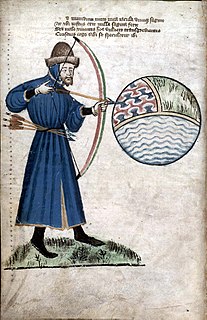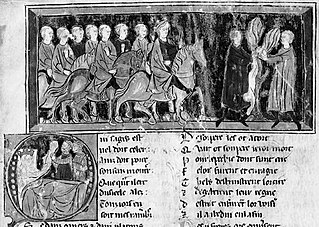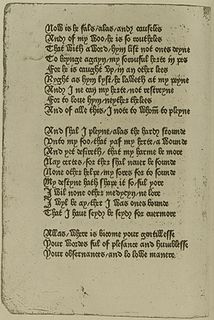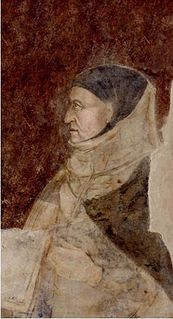Related Research Articles

The Canterbury Tales is a collection of twenty-four stories that runs to over 17,000 lines written in Middle English by Geoffrey Chaucer between 1387 and 1400. It is widely regarded as Chaucer's magnum opus. The tales are presented as part of a story-telling contest by a group of pilgrims as they travel together from London to Canterbury to visit the shrine of Saint Thomas Becket at Canterbury Cathedral. The prize for this contest is a free meal at the Tabard Inn at Southwark on their return.

Geoffrey Chaucer was an English poet, author, and civil servant best known for The Canterbury Tales. He has been called the "father of English literature", or, alternatively, the "father of English poetry". He was the first writer to be buried in what has since come to be called Poets' Corner, in Westminster Abbey. Chaucer also gained fame as a philosopher and astronomer, composing the scientific A Treatise on the Astrolabe for his 10-year-old son Lewis. He maintained a career in the civil service as a bureaucrat, courtier, diplomat, and member of parliament.

Giovanni Boccaccio was an Italian writer, poet, correspondent of Petrarch, and an important Renaissance humanist. Born in the town of Certaldo, he became so well known as a writer that he was sometimes simply known as "the Certaldese" and one of the most important figures in the European literary panorama of the fourteenth century. Some scholars define him as the greatest European prose writer of his time, a versatile writer who amalgamated different literary trends and genres, making them converge in original works, thanks to a creative activity exercised under the banner of experimentalism.

John Gower was an English poet, a contemporary of William Langland and the Pearl Poet, and a personal friend of Geoffrey Chaucer. He is remembered primarily for three major works, the Mirour de l'Omme, Vox Clamantis, and Confessio Amantis, three long poems written in French, Latin, and English respectively, which are united by common moral and political themes.
Rhyme royal is a rhyming stanza form that was introduced to English poetry by Geoffrey Chaucer. The form enjoyed significant success in the fifteenth century and into the sixteenth century. It has had a more subdued but continuing influence on English verse in more recent centuries.

John Lydgate of Bury was an English monk and poet, born in Lidgate, near Haverhill, Suffolk, England.

Medieval literature is a broad subject, encompassing essentially all written works available in Europe and beyond during the Middle Ages. The literature of this time was composed of religious writings as well as secular works. Just as in modern literature, it is a complex and rich field of study, from the utterly sacred to the exuberantly profane, touching all points in-between. Works of literature are often grouped by place of origin, language, and genre.
According to the medieval poet Jean Bodel, the Matter of Rome is the literary cycle of Greek and Roman mythology, together with episodes from the history of classical antiquity, focusing on military heroes like Alexander the Great and Julius Caesar. Bodel division of literary cycles also included the Matter of Britain and the Matter of France. The Matter of Rome includes the Matter of Troy, consisting of romances and other texts based on the Trojan War and its legacy, including the adventures of Aeneas.

"The Knight's Tale" is the first tale from Geoffrey Chaucer's The Canterbury Tales.

Troilus and Criseyde is an epic poem by Geoffrey Chaucer which re-tells in Middle English the tragic story of the lovers Troilus and Criseyde set against a backdrop of war during the siege of Troy. It was written in rime royale and probably completed during the mid-1380s. Many Chaucer scholars regard it as the poet's finest work. As a finished long poem it is more self-contained than the better known but ultimately unfinished The Canterbury Tales. This poem is often considered the source of the phrase: "all good things must come to an end" (3.615).

Troilus is a legendary character associated with the story of the Trojan War. The first surviving reference to him is in Homer's Iliad, which some scholars theorize was composed by "bards" (aoidoi) and sung in the late 9th or 8th century BC.

Romance of Thebes is a literary subject that has been treated in several languages.

Confessio Amantis is a 33,000-line Middle English poem by John Gower, which uses the confession made by an ageing lover to the chaplain of Venus as a frame story for a collection of shorter narrative poems. According to its prologue, it was composed at the request of Richard II. It stands with the works of Chaucer, Langland, and the Pearl poet as one of the great works of late 14th-century English literature. The Index of Middle English Verse shows that in the era before the printing press it was one of the most-often copied manuscripts along with Canterbury Tales and Piers Plowman.

Anelida and Arcite is a 357-line English poem by Geoffrey Chaucer. It tells the story of Anelida, queen of Armenia and her wooing by false Arcite from Thebes, Greece.

De casibus virorum illustrium is a work of 56 biographies in Latin prose composed by the Florentine poet Giovanni Boccaccio of Certaldo in the form of moral stories of the falls of famous people, similar to his work of 106 biographies De Mulieribus Claris.

The Decameron, subtitled Prince Galehaut and sometimes nicknamed l'Umana commedia, is a collection of short stories by the 14th-century Italian author Giovanni Boccaccio (1313–1375). The book is structured as a frame story containing 100 tales told by a group of seven young women and three young men; they shelter in a secluded villa just outside Florence in order to escape the Black Death, which was afflicting the city. Boccaccio probably conceived of the Decameron after the epidemic of 1348, and completed it by 1353. The various tales of love in The Decameron range from the erotic to the tragic. Tales of wit, practical jokes, and life lessons contribute to the mosaic. In addition to its literary value and widespread influence, it provides a document of life at the time. Written in the vernacular of the Florentine language, it is considered a masterpiece of classical early Italian prose.

Teseida is a long epic poem written by Giovanni Boccaccio c.1340–41. Running to almost 10,000 lines divided into twelve books, its notional subject is the career and rule of the ancient Greek hero Theseus (Teseo), although the majority of the epic tells the story of the rivalry of Palemone and Arcita for the love of Emilia. It is the main source of "The Knight's Tale" in Geoffrey Chaucer's Canterbury Tales, and therefore is the original source of The Two Noble Kinsmen, a collaboration by William Shakespeare and John Fletcher. The exact sources of Boccaccio's knowledge about the ancient Greek world are unknown, but is likely that he gained the knowledge through his close friendship with Paolo de Perugia, a medieval collector of ancient myths and tales.
English words first attested in Chaucer, or special manuscript words of Chaucer, are a set of about two thousand English words whose first use found in existing manuscripts is credited to Geoffrey Chaucer. This does not necessarily mean that he was the person to introduce these words into English, but that the earliest extant uses of these words are found in Chaucerian manuscripts. Many of the words were already in everyday speech in 14th-century England. The claim is that these words are found for the first time in written manuscripts where he introduced them in one of his extensive works from 1374 to 1400 as the first author to use these particular words. Many of Chaucer's special manuscript words are used today: absent, accident, add, agree, bagpipe, border, box, cinnamon, desk, digestion, dishonest, examination, finally, flute, funeral, galaxy, horizon, infect, ingot, latitude, laxative, miscarry, nod, obscure, observe, outrageous, perpendicular, Persian, princess, resolve, rumour, scissors, session, snort, superstitious, theatre, trench, universe, utility, vacation, Valentine, veal, village, vulgar, wallet, and wildness.

Contact between Geoffrey Chaucer and the Italian humanists Petrarch or Boccaccio has been proposed by scholars for centuries. More recent scholarship tends to discount these earlier speculations because of lack of evidence. As Leonard Koff remarks, the story of their meeting is "a 'tydying' worthy of Chaucer himself".
Harley MS 7334, sometimes known as the Harley Manuscript, is a mediaeval manuscript of Chaucer's Canterbury Tales held in the Harleian Collection of the British Library.
References
- 1 2 3 Kline, Daniel T. (1999). "Father Chaucer and the "Siege of Thebes": Literary Paternity, Aggressive Deference, and the Prologue to Lydgate's Oedipal Canterbury Tale". The Chaucer Review. 34 (2): 218. JSTOR 25096088.
- 1 2 Meyer-Lee, Robert J. (2013). A Companion to 15th Century English Poetry. D. S. Brewer, Boydell & Brewer. p. 59.
- 1 2 3 4 Straker, Scott-Morgan (2001). "Deference and Difference, Lydgate, Chaucer, and "Siege of Thebes"". The Review of English Studies. New Series. 52 (205): 1–2. JSTOR 3070488.
- ↑ Battles, Dominique (2004). The Medieval Tradition of Thebes: History and Narrative in the OF Roman de Thèbes, Boccaccio, Chaucer, and Lydgate. New York and London: Routledge. pp. xiii. ISBN 0-203-50285-X – via Google Books.
- 1 2 "The Siege of Thebes: Introduction | Robbins Library Digital Projects" . Retrieved 16 January 2017.
- 1 2 "John Lydgate | English writer". Encyclopedia Britannica. Retrieved 16 January 2017.
- ↑ "The Siege of Thebes: Introduction | Robbins Library Digital Projects" . Retrieved 17 January 2017.